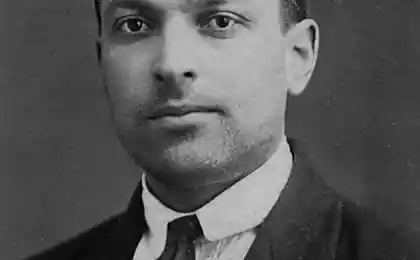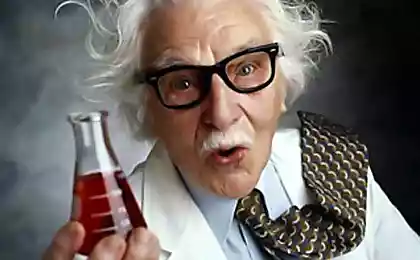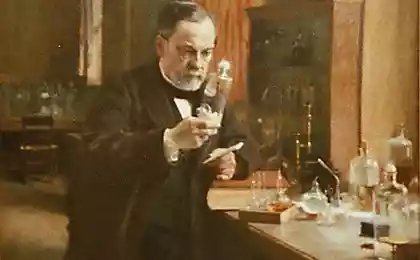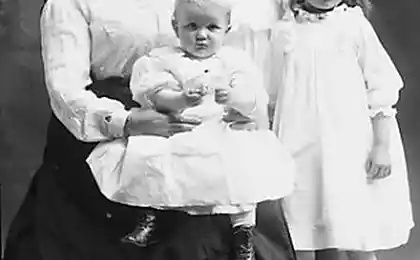1209
Cruel experiments in the history of psychology (7 photos)
Little Albert (1920)
John Watson, the father of the behavioral trends in psychology, was engaged in research of nature fears and phobias. Studying the emotions of infants Watson, among others, interested in the possibility of the formation reactions of fear in relation to the objects that previously did not cause fear. The scientists tested the possibility of forming an emotional reaction of fear of a white rat in 9-month-old boy Albert, who is not afraid of a rat, and even liked to play with her.
In the experiment, within two months of the infant orphan from the orphanage showed a manual white rat, white rabbit, cotton wool, mask Santa Claus beard, etc. Two months later, the baby was put on the mat in the middle of the room and was allowed to play with a rat. Initially, the child did not afraid of rats and quietly played with her. After some time, Watson began hitting iron hammer on a metal plate behind the baby whenever Albert touched the rat. After repeated attacks, Albert began to avoid contact with the rat. A week later the experiment was repeated - this time on the band hit five times by simply placing the rat in the crib. The baby has cried at the sight of a white rat.
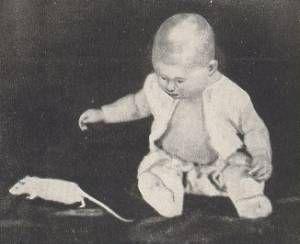
another five days Watson decided to check whether the child is afraid of similar objects. A child afraid of the white rabbit wool mask Santa Claus. As loud noises when displaying items not published scientist, Watson concluded transfer reactions of fear. Watson suggested that many fears, dislikes and anxiety of adults are formed in early childhood. Unfortunately, Watson did not manage to deliver the baby Albert from his irrational fear that was fixed for life.
Milgram experiment (1974)
The experiment Stanley Milgram of Yale University is described by the author in his book "Obedience to authority: An experimental study." The experience was an experimenter, the subject and the actor who played the role of another test. At the beginning of the experiment between the test and the actor "by lot" distributed as a "teacher" and "student". In fact, the subject always got the role of "teacher" and hired an actor has always been a "disciple." "Master" before the start of the experiment explained that the purpose of the experience - ostensibly to identify new methods of storing information. In reality, the experimenter to study the behavior of the person receiving the instructions at variance with its internal norms of behavior, from a reputable source.
"Apprentice" tied to a chair, to which was attached a stun gun. As a "student" and "teacher" received "demo" shock of 45 volts. Next "teacher" went into another room and was on the speakerphone to give the "student" simple tasks on memorization. With each error student subject had to press a button, and the student gets an electric shock of 45 volts. In fact, the actor who played the pupil, only pretended to get an electric shock. Then, after each error, the teacher had to increase the voltage to 15 volts. At one point, the actor began to demand to stop the experiment. "Master" began to doubt, and this experimenter said, "The experiment requires that you continue. Please continue ».
As the tension actor played more severe discomfort, severe pain, and then finally broke the cry. The experiment was continued until a voltage of 450 volts. If the "teacher" hesitated, the experimenter assured him that he takes full responsibility for the experiment and for the safety of "student" and that the experiment should be continued. The results were shocking: 65% of the "teachers" gave discharge 450 volts, knowing that "disciple" feels terrible pain.
Despite all the preliminary forecasts experimenters, most subjects obeyed instructions led the experiment, scientists and punished "student" an electric shock, and in a series of experiments of the forty subjects neither stopped to 300 volts, five refused to obey only after this level, and 26 "teachers" of 40 have reached the end of the scale.
Critics said that the authority of the hypnotized subjects at Yale University. In response to this criticism, he repeated the Milgram experiment, removing the miserable room in the town of Bridgeport (Connecticut) under the guise of 'Research Association of Bridgeport. " The results are qualitatively unchanged: 48% of the subjects agreed to go to the end of the scale.
In 2002, the consolidated results of similar experiments showed that by the end of the income scale from 61% to 66% of the "teachers", regardless of the time and place of the experiment. Conclusions from the experiment followed the most frightening: unknown dark side of human nature is prone not only to thoughtlessly obey authority and perform the most unimaginable directions, but also to justify their own behavior received the "Order". Many of the study participants had a feeling of superiority over the "disciples" and clicking on the button, we were convinced that the "student", the wrong answer to a question, gets his due.
Ultimately, the results of the experiment showed that the need for obedience to authority is rooted in our consciousness so deeply that the subjects continued to follow instructions, despite the anguish and strong internal conflict.
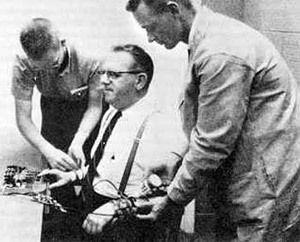
Stanford Prison Experiment (1971)
Experiment with "artificial prison" not intended by its creator as something unethical or harmful to the psyche of its members, but the results of this study shocked the public. Psychologist Philip Zimbardo Known decided to study the behavior and social norms of the individuals placed in unusual conditions for them in prison and forced to play the role of prisoners or guards. To do this, in the basement of the Faculty of Psychology equipped simulated prison and student volunteers in the amount of 24 people divided into "prisoners" and "guards».
It was assumed that the "prisoners" was initially placed in a situation in which they will experience disorientation and personality degradation, up to complete depersonalization. "Overseers" did not give any special instructions regarding their roles. Initially, the students do not really understand how they should play their role, but on the second day of the experiment, everything fell into place: the rebellion "prisoners" were brutally suppressed "overseers." From this point on both sides of the behavior has changed radically. "Guards" have developed a special system of privileges designed to divide the "prisoners" and dwelt in them distrust of each other - one by one, they are not as strong as together, and so they are easier to "protect." "Overseers," it seemed that the "prisoners" are always ready to raise a new "revolt", and tightened control system to an extreme degree, "prisoners" are not left alone with yourself, even in the toilet.
As a result, "prisoners" began to experience emotional distress, depression, helplessness. After some time to visit the "prisoners" came "to the prison chaplain." When asked their names, "prisoners" often called their numbers, not names, but a question of how they are going to get out of prison and brought them to a standstill. To the dismay of the experimenters it turned out that the "prisoners" absolutely got used to their roles and have begun to feel in this prison, and "supervisors" experienced real sadistic emotions and intentions with respect to the "prisoners", a few days ago, their former good friends. It seemed that both sides completely forgotten that all this is - just an experiment. Although the experiment was scheduled for two weeks, he was terminated prematurely after only six days because of ethical considerations.
On the basis of this experiment Oliver Hirschbiegel directed the film "Experiment" (2001).

"The monstrous experiment" (1939)
In 1939, Wendell Johnson at the University of Iowa (USA) and his graduate student Mary Tudor had a shocking experiment involving 22 orphans from Davenport. Children were divided into control and experimental groups. Half of the children experimenters told about how clean and well they speak.
The second half of the children were expecting unpleasant moments: Mary Tudor, spared no epithets sarcastically mocked the slightest fault of their speech, eventually calling all miserable stammering. As a result of the experiment, many children who have never experienced problems with speech and find themselves unexpectedly in the "negative" group developed all the symptoms of stuttering that persists throughout their lives.
The experiment was later called "monstrous", long concealed from the public for fear of damaging the reputation of Johnson: Similar experiments were later conducted on prisoners of concentration camps in Nazi Germany. In 2001, the University of Iowa issued a formal apology to all the victims in the study.
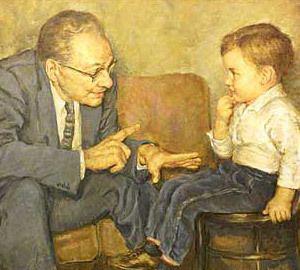
The "Aversi" (1970)
In the army of South Africa from 1970 to 1989, it carried out a secret program to clean up the ranks of the army troops sexual orientation. Log came all funds from electroshock treatment to chemical castration. The exact number of victims is unknown, however, according to the army doctors in the "cleansing" of various forbidden experiments on human nature suffered about 1,000 troops.
Army psychiatrists on behalf of the command in full to "eradicate" homosexuals: those who do not give in "treatment", sent to the shock therapy, forced to take hormonal drugs or even undergo surgery to change sex. In most cases, "patients" were young white males aged 16 to 24 years. Head of "research", Dr. Aubrey Levin, now a professor of psychiatry at the University of Calgary (Canada). In private practice.

Research on the effects of drugs on the body (1969)
It should be recognized that some of the experiments carried out on animals, help scientists devise drugs that can later save tens of thousands of lives. However, some studies go all boundaries of ethics. An example is an experiment designed to help scientists understand the rate and extent of human addiction to narcotic substances.
The experiment was performed in rats and monkeys as animal closest to human physiology. The animals were trained to self-inject the dose of certain drugs: morphine, cocaine, codeine, amphetamines, etc. As soon as the animals learn how to "shoot up" the experimenters left them a large amount of drugs, provided the animals themselves and start watching.
Animals are so confused that some of them even tried to escape, and while under the influence of drugs, they maim and do not feel pain. Monkeys who took cocaine, began to suffer from convulsions and hallucinations: poor animals pulled himself phalanges. Monkeys, "sitting" on amphetamines, pulled at all wool. -Animals "addicts" who preferred "cocktail" of cocaine and morphine, died within 2 weeks after receiving the drug.
Despite the fact that the purpose of the experiment was to understand and assess the impact of drugs on the human body with the intention of further developing an effective drug treatment, how to achieve the results can hardly be called humane.
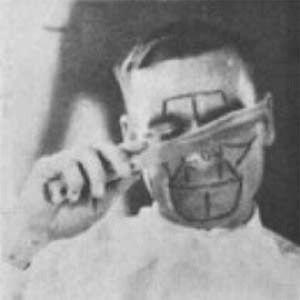
Experiments Landis: spontaneous facial expressions and subordination (1924)
In 1924 Carini Landis of the University of Minnesota began studying human facial expressions. The experiment had started scientists had to identify common patterns of working groups of facial muscles responsible for the expression of certain emotional states, and find a facial expression typical of the fear, embarrassment or other emotions. The subjects were his own students. To make facial expressions more distinct, he drew a line on the faces of the subjects with burnt cork, and then impose them something that can cause strong emotions made them smell ammonia, listen to jazz, look at pornographic pictures and put their hands in a bucket of frogs.
At the time of the expression of emotions students photographed. And all would do, but the final test, which subjected the students Landis caused rumors among the widest circles of scientists and psychologists. Landis asked each subject to cut off the head of a white rat. All study participants initially refused to do so, many were crying and screaming, but then most of them have agreed to do it. Worst of all was the fact that most participants in the experiment, they say, in life and not hurt a fly and had no idea how to implement the order of the experimenter. As a result, the animals have caused a lot of anguish.
The effects of the experiment were much more important than the experiment itself. There is no regularity in the scientist's expression could not be found, however, psychologists have received proof of how easily people are willing to obey authority and do what in normal situations would not have done.
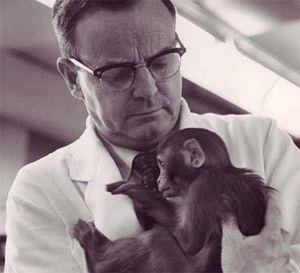
Learned helplessness (1966)
In 1966, psychologists Mark Seligman and Steve Maier conducted a series of experiments on dogs. Animals were placed in the cells pre-divided into three groups. The control group after a while released without causing any harm, the second group of animals was subjected to repeated electric shocks that could stop pressing the lever on the inside, and the third group of animals was subjected to a sudden shock current, which could not be prevented.
As a result, the dog developed a so-called "learned helplessness" - a reaction to unpleasant stimuli, based on the conviction of helplessness in the outside world. Soon, the animals began to show signs of clinical depression. After a while, the dogs from the third group was released from the cells and planted in open-air cages, from which it was easy to escape. Dogs again subjected to an electric current, but none of them had not even thought about running away. Instead, they passively react to the pain, seeing it as inevitable. Dogs have learned for myself from the previous negative experiences that escape is impossible and never made any attempt to escape from the cell.
Scientists have suggested that the human stress response is a lot like a dog, people become helpless after several failures, one after another. It is unclear, whether such a cost, vobzem something banal conclusion of suffering poor animals.
"The source of despair" (1960)
His cruel experiments, Harry Harlow conducted on monkeys. Exploring the issue of social exclusion of the individual and the methods of protection against her, Harlow took away baby monkey from his mother and placed in a cell alone, and chose the young, whose relationship with her mother was the most robust. Monkey Caged year, after which it was released.
The majority of individuals were found various mental disorders. The scientist concluded that: even the happy childhood is not protected from depression. The results, to put it mildly, is not impressive: this conclusion could be done without a cruel animal experiments. However, the movement to protect the rights of animals has begun after the publication of the results of this experiment.
"Of Boy Girl" (1965)
In 1965, the eight-month baby Bruce Reimer, who was born in Winnipeg, Canada, on the advice of doctors underwent circumcision. However, due to an error of the surgeon who performed the operation, the boy's penis was completely damaged.
Psychologist John Money of Johns Hopkins University in Baltimore (USA), which seek the advice of the child's parents and advised them to "easy" way out of the light of the situation: Back to sex of the baby and raise him as a girl until he grew up and began to experience complexes about his impotency.
It Said - done: Bruce soon became a brand. Distressed parents are unaware that their child was the victim of a cruel experiment: John Money was looking for an opportunity to prove that sexual identity is not due to the nature and upbringing, and Bruce was the perfect object of observation.
The boy removed the testicles, and then for several years, Mani published in scientific journals reports "successful" development of its experimental. "It is clear that the child behaves like an active little girl and her behavior is very different from the boyish behavior of her twin brother," - says the scientist.
However, their homes, and teachers at the school noticed the child's typical boyish behavior and biased perception. Worst of all was the fact that parents are hiding from his son-daughter truth, experience strong emotional stress.
John Watson, the father of the behavioral trends in psychology, was engaged in research of nature fears and phobias. Studying the emotions of infants Watson, among others, interested in the possibility of the formation reactions of fear in relation to the objects that previously did not cause fear. The scientists tested the possibility of forming an emotional reaction of fear of a white rat in 9-month-old boy Albert, who is not afraid of a rat, and even liked to play with her.
In the experiment, within two months of the infant orphan from the orphanage showed a manual white rat, white rabbit, cotton wool, mask Santa Claus beard, etc. Two months later, the baby was put on the mat in the middle of the room and was allowed to play with a rat. Initially, the child did not afraid of rats and quietly played with her. After some time, Watson began hitting iron hammer on a metal plate behind the baby whenever Albert touched the rat. After repeated attacks, Albert began to avoid contact with the rat. A week later the experiment was repeated - this time on the band hit five times by simply placing the rat in the crib. The baby has cried at the sight of a white rat.

another five days Watson decided to check whether the child is afraid of similar objects. A child afraid of the white rabbit wool mask Santa Claus. As loud noises when displaying items not published scientist, Watson concluded transfer reactions of fear. Watson suggested that many fears, dislikes and anxiety of adults are formed in early childhood. Unfortunately, Watson did not manage to deliver the baby Albert from his irrational fear that was fixed for life.
Milgram experiment (1974)
The experiment Stanley Milgram of Yale University is described by the author in his book "Obedience to authority: An experimental study." The experience was an experimenter, the subject and the actor who played the role of another test. At the beginning of the experiment between the test and the actor "by lot" distributed as a "teacher" and "student". In fact, the subject always got the role of "teacher" and hired an actor has always been a "disciple." "Master" before the start of the experiment explained that the purpose of the experience - ostensibly to identify new methods of storing information. In reality, the experimenter to study the behavior of the person receiving the instructions at variance with its internal norms of behavior, from a reputable source.
"Apprentice" tied to a chair, to which was attached a stun gun. As a "student" and "teacher" received "demo" shock of 45 volts. Next "teacher" went into another room and was on the speakerphone to give the "student" simple tasks on memorization. With each error student subject had to press a button, and the student gets an electric shock of 45 volts. In fact, the actor who played the pupil, only pretended to get an electric shock. Then, after each error, the teacher had to increase the voltage to 15 volts. At one point, the actor began to demand to stop the experiment. "Master" began to doubt, and this experimenter said, "The experiment requires that you continue. Please continue ».
As the tension actor played more severe discomfort, severe pain, and then finally broke the cry. The experiment was continued until a voltage of 450 volts. If the "teacher" hesitated, the experimenter assured him that he takes full responsibility for the experiment and for the safety of "student" and that the experiment should be continued. The results were shocking: 65% of the "teachers" gave discharge 450 volts, knowing that "disciple" feels terrible pain.
Despite all the preliminary forecasts experimenters, most subjects obeyed instructions led the experiment, scientists and punished "student" an electric shock, and in a series of experiments of the forty subjects neither stopped to 300 volts, five refused to obey only after this level, and 26 "teachers" of 40 have reached the end of the scale.
Critics said that the authority of the hypnotized subjects at Yale University. In response to this criticism, he repeated the Milgram experiment, removing the miserable room in the town of Bridgeport (Connecticut) under the guise of 'Research Association of Bridgeport. " The results are qualitatively unchanged: 48% of the subjects agreed to go to the end of the scale.
In 2002, the consolidated results of similar experiments showed that by the end of the income scale from 61% to 66% of the "teachers", regardless of the time and place of the experiment. Conclusions from the experiment followed the most frightening: unknown dark side of human nature is prone not only to thoughtlessly obey authority and perform the most unimaginable directions, but also to justify their own behavior received the "Order". Many of the study participants had a feeling of superiority over the "disciples" and clicking on the button, we were convinced that the "student", the wrong answer to a question, gets his due.
Ultimately, the results of the experiment showed that the need for obedience to authority is rooted in our consciousness so deeply that the subjects continued to follow instructions, despite the anguish and strong internal conflict.

Stanford Prison Experiment (1971)
Experiment with "artificial prison" not intended by its creator as something unethical or harmful to the psyche of its members, but the results of this study shocked the public. Psychologist Philip Zimbardo Known decided to study the behavior and social norms of the individuals placed in unusual conditions for them in prison and forced to play the role of prisoners or guards. To do this, in the basement of the Faculty of Psychology equipped simulated prison and student volunteers in the amount of 24 people divided into "prisoners" and "guards».
It was assumed that the "prisoners" was initially placed in a situation in which they will experience disorientation and personality degradation, up to complete depersonalization. "Overseers" did not give any special instructions regarding their roles. Initially, the students do not really understand how they should play their role, but on the second day of the experiment, everything fell into place: the rebellion "prisoners" were brutally suppressed "overseers." From this point on both sides of the behavior has changed radically. "Guards" have developed a special system of privileges designed to divide the "prisoners" and dwelt in them distrust of each other - one by one, they are not as strong as together, and so they are easier to "protect." "Overseers," it seemed that the "prisoners" are always ready to raise a new "revolt", and tightened control system to an extreme degree, "prisoners" are not left alone with yourself, even in the toilet.
As a result, "prisoners" began to experience emotional distress, depression, helplessness. After some time to visit the "prisoners" came "to the prison chaplain." When asked their names, "prisoners" often called their numbers, not names, but a question of how they are going to get out of prison and brought them to a standstill. To the dismay of the experimenters it turned out that the "prisoners" absolutely got used to their roles and have begun to feel in this prison, and "supervisors" experienced real sadistic emotions and intentions with respect to the "prisoners", a few days ago, their former good friends. It seemed that both sides completely forgotten that all this is - just an experiment. Although the experiment was scheduled for two weeks, he was terminated prematurely after only six days because of ethical considerations.
On the basis of this experiment Oliver Hirschbiegel directed the film "Experiment" (2001).

"The monstrous experiment" (1939)
In 1939, Wendell Johnson at the University of Iowa (USA) and his graduate student Mary Tudor had a shocking experiment involving 22 orphans from Davenport. Children were divided into control and experimental groups. Half of the children experimenters told about how clean and well they speak.
The second half of the children were expecting unpleasant moments: Mary Tudor, spared no epithets sarcastically mocked the slightest fault of their speech, eventually calling all miserable stammering. As a result of the experiment, many children who have never experienced problems with speech and find themselves unexpectedly in the "negative" group developed all the symptoms of stuttering that persists throughout their lives.
The experiment was later called "monstrous", long concealed from the public for fear of damaging the reputation of Johnson: Similar experiments were later conducted on prisoners of concentration camps in Nazi Germany. In 2001, the University of Iowa issued a formal apology to all the victims in the study.

The "Aversi" (1970)
In the army of South Africa from 1970 to 1989, it carried out a secret program to clean up the ranks of the army troops sexual orientation. Log came all funds from electroshock treatment to chemical castration. The exact number of victims is unknown, however, according to the army doctors in the "cleansing" of various forbidden experiments on human nature suffered about 1,000 troops.
Army psychiatrists on behalf of the command in full to "eradicate" homosexuals: those who do not give in "treatment", sent to the shock therapy, forced to take hormonal drugs or even undergo surgery to change sex. In most cases, "patients" were young white males aged 16 to 24 years. Head of "research", Dr. Aubrey Levin, now a professor of psychiatry at the University of Calgary (Canada). In private practice.

Research on the effects of drugs on the body (1969)
It should be recognized that some of the experiments carried out on animals, help scientists devise drugs that can later save tens of thousands of lives. However, some studies go all boundaries of ethics. An example is an experiment designed to help scientists understand the rate and extent of human addiction to narcotic substances.
The experiment was performed in rats and monkeys as animal closest to human physiology. The animals were trained to self-inject the dose of certain drugs: morphine, cocaine, codeine, amphetamines, etc. As soon as the animals learn how to "shoot up" the experimenters left them a large amount of drugs, provided the animals themselves and start watching.
Animals are so confused that some of them even tried to escape, and while under the influence of drugs, they maim and do not feel pain. Monkeys who took cocaine, began to suffer from convulsions and hallucinations: poor animals pulled himself phalanges. Monkeys, "sitting" on amphetamines, pulled at all wool. -Animals "addicts" who preferred "cocktail" of cocaine and morphine, died within 2 weeks after receiving the drug.
Despite the fact that the purpose of the experiment was to understand and assess the impact of drugs on the human body with the intention of further developing an effective drug treatment, how to achieve the results can hardly be called humane.

Experiments Landis: spontaneous facial expressions and subordination (1924)
In 1924 Carini Landis of the University of Minnesota began studying human facial expressions. The experiment had started scientists had to identify common patterns of working groups of facial muscles responsible for the expression of certain emotional states, and find a facial expression typical of the fear, embarrassment or other emotions. The subjects were his own students. To make facial expressions more distinct, he drew a line on the faces of the subjects with burnt cork, and then impose them something that can cause strong emotions made them smell ammonia, listen to jazz, look at pornographic pictures and put their hands in a bucket of frogs.
At the time of the expression of emotions students photographed. And all would do, but the final test, which subjected the students Landis caused rumors among the widest circles of scientists and psychologists. Landis asked each subject to cut off the head of a white rat. All study participants initially refused to do so, many were crying and screaming, but then most of them have agreed to do it. Worst of all was the fact that most participants in the experiment, they say, in life and not hurt a fly and had no idea how to implement the order of the experimenter. As a result, the animals have caused a lot of anguish.
The effects of the experiment were much more important than the experiment itself. There is no regularity in the scientist's expression could not be found, however, psychologists have received proof of how easily people are willing to obey authority and do what in normal situations would not have done.

Learned helplessness (1966)
In 1966, psychologists Mark Seligman and Steve Maier conducted a series of experiments on dogs. Animals were placed in the cells pre-divided into three groups. The control group after a while released without causing any harm, the second group of animals was subjected to repeated electric shocks that could stop pressing the lever on the inside, and the third group of animals was subjected to a sudden shock current, which could not be prevented.
As a result, the dog developed a so-called "learned helplessness" - a reaction to unpleasant stimuli, based on the conviction of helplessness in the outside world. Soon, the animals began to show signs of clinical depression. After a while, the dogs from the third group was released from the cells and planted in open-air cages, from which it was easy to escape. Dogs again subjected to an electric current, but none of them had not even thought about running away. Instead, they passively react to the pain, seeing it as inevitable. Dogs have learned for myself from the previous negative experiences that escape is impossible and never made any attempt to escape from the cell.
Scientists have suggested that the human stress response is a lot like a dog, people become helpless after several failures, one after another. It is unclear, whether such a cost, vobzem something banal conclusion of suffering poor animals.
"The source of despair" (1960)
His cruel experiments, Harry Harlow conducted on monkeys. Exploring the issue of social exclusion of the individual and the methods of protection against her, Harlow took away baby monkey from his mother and placed in a cell alone, and chose the young, whose relationship with her mother was the most robust. Monkey Caged year, after which it was released.
The majority of individuals were found various mental disorders. The scientist concluded that: even the happy childhood is not protected from depression. The results, to put it mildly, is not impressive: this conclusion could be done without a cruel animal experiments. However, the movement to protect the rights of animals has begun after the publication of the results of this experiment.
"Of Boy Girl" (1965)
In 1965, the eight-month baby Bruce Reimer, who was born in Winnipeg, Canada, on the advice of doctors underwent circumcision. However, due to an error of the surgeon who performed the operation, the boy's penis was completely damaged.
Psychologist John Money of Johns Hopkins University in Baltimore (USA), which seek the advice of the child's parents and advised them to "easy" way out of the light of the situation: Back to sex of the baby and raise him as a girl until he grew up and began to experience complexes about his impotency.
It Said - done: Bruce soon became a brand. Distressed parents are unaware that their child was the victim of a cruel experiment: John Money was looking for an opportunity to prove that sexual identity is not due to the nature and upbringing, and Bruce was the perfect object of observation.
The boy removed the testicles, and then for several years, Mani published in scientific journals reports "successful" development of its experimental. "It is clear that the child behaves like an active little girl and her behavior is very different from the boyish behavior of her twin brother," - says the scientist.
However, their homes, and teachers at the school noticed the child's typical boyish behavior and biased perception. Worst of all was the fact that parents are hiding from his son-daughter truth, experience strong emotional stress.







